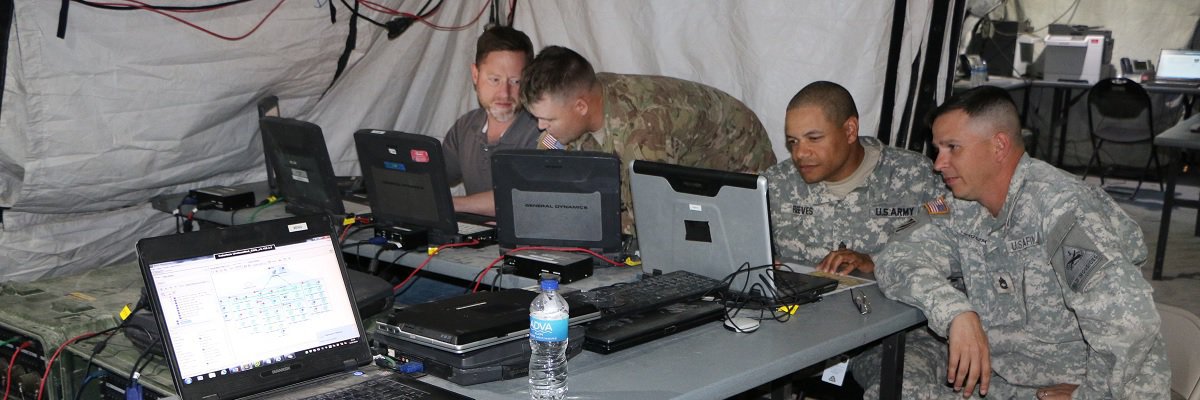Palantir, a data mining startup based in Silicon Valley, will be handling initial delivery of the U.S. Army’s battlefield intelligence network, the Pentagon confirmed earlier this year, positioning the company to influence the Army’s long-term implementation of its artificial intelligence priorities.
Part of a military-wide intelligence sharing platform, the Distributed Common Ground System is comprised of commercial, government, and open source components, a “system of systems” to facilitate centralization, analysis, and dissemination of the military’s data across each of its branches. The recent award to Palantir for redesigning the Army’s portion, known as DCGS-A, could be worth more than $800 million over the next 10 years and will be active in every region the Army operates in. This award is one of the first military awards of its size to go to a technology startup, which bid against veteran defense contractor Raytheon for the solicitation.
As the Department of Defense emphasizes real-time data analysis as part of its strategy, software companies are seeing opportunities to vie for big-ticket government contracts and fighting in court for the right to pursue them. Palantir challenged the Army’s original procurement order, which it argued should be broken into multiple work orders; the Government Accountability Office disagreed, but the Federal Court of Claims decided the Army’s procurement design was flawed. A similar battle is currently playing out regarding the Pentagon’s $10 billion single source contract for a cloud computing service.
Palantir currently holds contracts with a number of federal agencies, including at the Department of Health and Human Services and Immigration and Customs Enforcement, which has inspired online protests from some of its employees.
Though there isn’t explicit mention of artificial intelligence in the solicitation, which was first released in 2015, the system will likely figure into future Army attempts to integrate AI into any of its intelligence systems.
For over a year, the Department of Defense has discussed the need to prioritize integration of AI into its operations. During his time in the Trump Administration, former Secretary of Defense General James Mattis introduced in the National Defense Strategy a formal emphasis on AI as crucial to national security, urging President Trump to consider a national AI strategy. The DoD announced in June 2018 that it would be launching a Joint Artificial Intelligence Center to coordinate the development and implementation of AI technologies across the military’s branches. In February, Trump signed an executive order, prioritizing the development of AI across the government, followed the next day by the release of the DoD’s own AI strategy. The Fiscal Year 2020 budget asks for $220 million to expand the JAIC’s operations.
The Army itself has created an AI Task Force, based at Carnegie Mellon University, to form its strategy, recently announcing it would be awarding the school $72 million to create complementary AI products based on the Task Force’s recommendations. It has also established the Army Futures Command, located in downtown Austin, Texas, for coordination of its approach to future warfare.
## Know of an algorithmic development near you? Click here to let us know.
Using big data to break into defense
Palantir has used the increased emphasis on big data — and a more AI-enabled future — to fight its way into military contracts that are usually reserved for vendors with years of experience and defense department relationships. The company essentially argued, first with the GAO and then in court, that the software it was already selling to commercial and other governmental clients was close enough to the military’s needs to avoid custom contracting development work that the DoD initially envisioned.
Traditional defense contractors, unsurprisingly, disagreed with the decision.
“The Army plans to award multiple delivery orders for systems over that time. While we are disappointed in the Army’s decision on the initial delivery order, it represents a relatively small number of systems,” Raytheon spokesperson Chris Johnson wrote in a statement. “We will actively compete for future delivery orders as we continue to work closely with the Army to help them meet their intelligence needs.”
But good governance groups also raised concerns, saying that awarding the business as an off-the-shelf contract could cause problems down the line.
“The Palantir case is very significant because it enforces mandates that agencies look to buy commercial products and services. Not reinventing the wheel seems like a great plan,” said Scott Amey with the Project on Government Oversight. “The problem, however, is that agencies must now spend time and resources to shop for products and services and be forced to buy them without taxpayer contracting controls.”
A lot of money has already been spent on the development of its major Information Technology projects, designated as Major Automated Information Systems, according to a March 2017 GAO report.
As services go from specialized to commonplace, the government is constantly redefining the difference between commercial and non-commercial products.
“There are significant differences between buying a commercial item, and buying an item that has been manufactured to comply with government specifications,” said Ralph White, Managing Associate General Counsel for Procurement Law at the GAO. “When a commercial item is purchased, there is much less intrusion by the government into the company’s internal business decisions. Generally, when it buys commercial items the government will not ask about things like manufacturing costs, profits, or a company’s method for allocating costs. These considerations are more appropriate when buying a government specified system from a company like General Dynamics or Boeing; they make less sense when the government is buying something that is commercially available, like an electric fan.”
The March 2017 GAO report is embedded below.

Algorithmic Control by MuckRock Foundation is licensed under a Creative Commons Attribution 4.0 International License.
Based on a work at https://www.muckrock.com/project/algorithmic-control-automated-decisionmaking-in-americas-cities-84/.
Image by Mr. Kyle Bond (PEO C3T) via U.S Army




